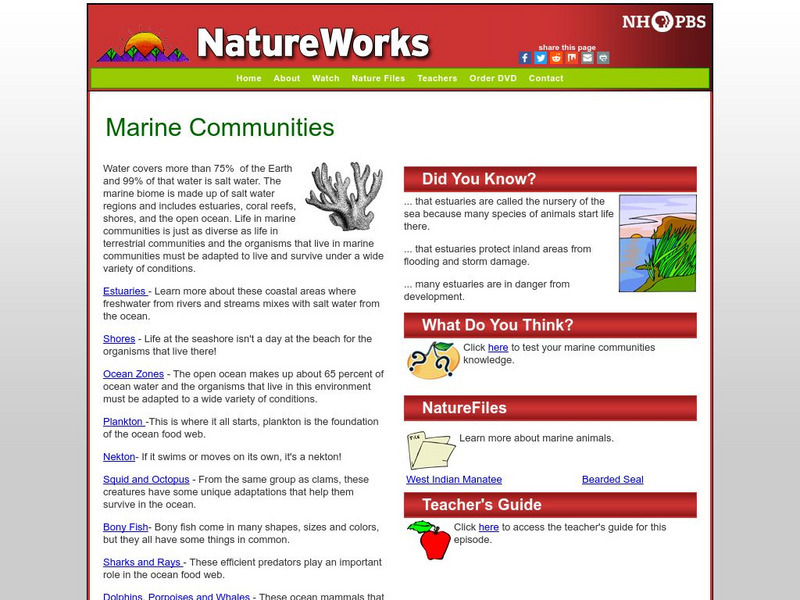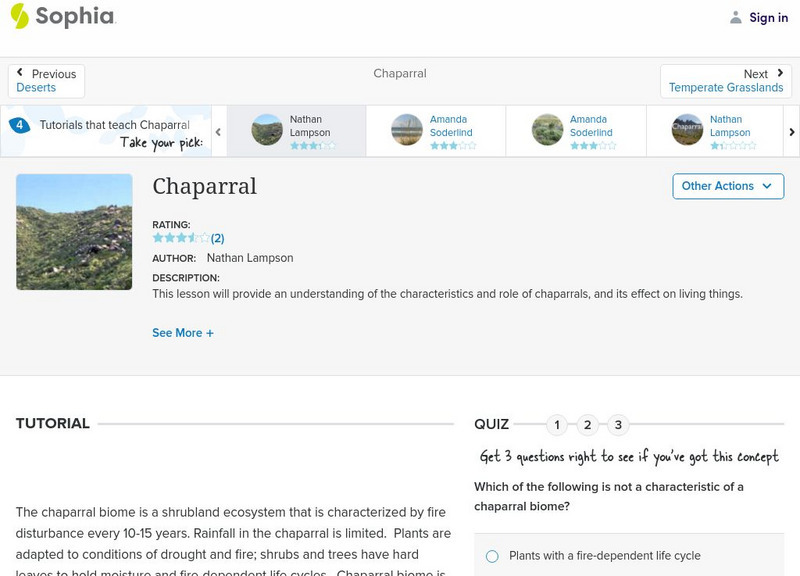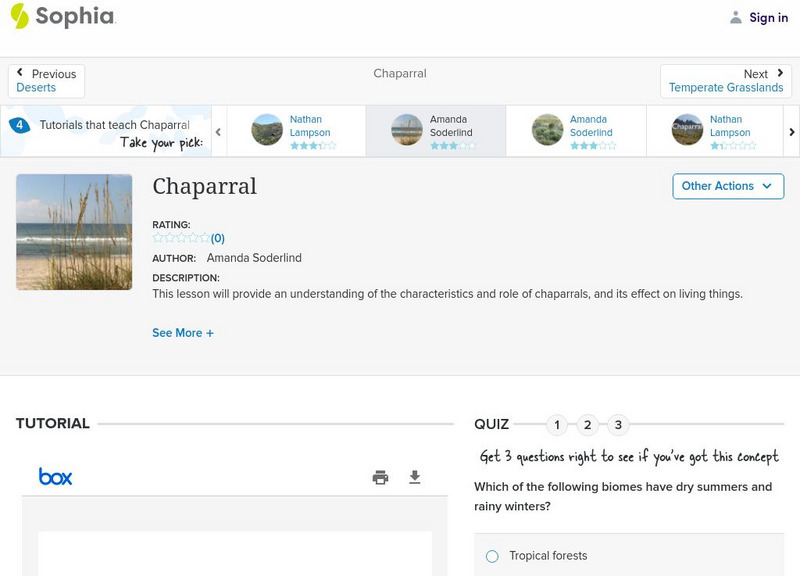PBS
Nh Pbs: Nature Works: Marine Communities
Explore saltwater ecosystems around Earth. Learn about oceans, estuaries, shores, and more.
E-learning for Kids
E Learning for Kids: Nova Zembla: How Does Temperature Affect Plant Growth?
Viktor brought his pet plant on his trip to Nova Zembla. Help him figure out what to do to take care of the plant.
CK-12 Foundation
Ck 12: Earth Science: Climate Zones and Biomes
[Free Registration/Login may be required to access all resource tools.] Describes how regions with similar climates are grouped into climate zones and biomes.
PBS
Nh Pbs: Nature Works: Temperate Deciduous Forests
NatureWorks offers some fascinating information about the Temperate Deciduous Forests. Students and teachers will learn what makes these forests special, what animals live in this biome, what plants grow in this biome, and more.
PBS
Nh Pbs: Nature Works: Terrestrial Communities
Explore land ecosystems around Earth. Learn about forests, tundra, taiga, grasslands, and deserts.
CK-12 Foundation
Ck 12: Biology: Organization of Living Things
[Free Registration/Login may be required to access all resource tools.] How organisms are organized.
Michigan Reach Out
Newton's Apple: Rain Forest Animals
Several activities to incorporate into your Rain Forest unit. This site does not focus only on animals.
Sophia Learning
Sophia: Chaparral: Lesson 2
This lesson will provide an understanding of the characteristics and role of chaparrals, and its effect on living things. It is 2 of 5 in the series titled "Chaparral."
Sophia Learning
Sophia: Chaparral: Lesson 4
This lesson will provide an understanding of the characteristics and role of chaparrals, and its effect on living things. It is 4 of 5 in the series titled "Chaparral."
Sophia Learning
Sophia: Chaparral: Lesson 5
This lesson will provide an understanding of the characteristics and role of chaparrals, and its effect on living things. It is 5 of 5 in the series titled "Chaparral."
Ducksters
Ducksters: Science for Kids: Coral Reef Biome
Kids learn about the coral reef biome. Much of ocean life lives in this important aquatic ecosystem.
Ducksters
Ducksters: Science for Kids: Desert Biome
Kids learn about the desert biome. The dryest areas on Earth still have plant and animal life.
Ducksters
Ducksters: Science for Kids: Marine or Ocean Biome
Kids learn about the marine biome. The largest biome by far, the oceans cover most of the Earth's surface.
Ducksters
Ducksters: Science for Kids: Taiga Forest Biome
Kids learn about the taiga forest biome. The largest of the land biomes is known for its evergreen trees.
Ducksters
Ducksters: Science for Kids: Temperate Forest Biome
Kids learn about the temperate forest biome. Four distinct seasons and lots of trees.
Sophia Learning
Sophia: Chaparral: Lesson 3
This lesson will provide an understanding of the characteristics and role of chaparrals, and its effect on living things. It is 3 of 5 in the series titled "Chaparral."
The Environmental Literacy Council
Environmental Literacy Council: Ecosystems
Article explaining ecosystems and why we use them to organize our ideas about the natural world. Links to additional resources, maps, and activities.
ClassFlow
Class Flow: Ecosystems
[Free Registration/Login Required] This flipchart explores the different ecosystems of the world, enhanced by embedded videos showing both the landscape and the plants and animals that can be found there.
ClassFlow
Class Flow: Identify the Animal and Its Biome
[Free Registration/Login Required] Each page contains a hidden picture of an animal. Students use a small viewer to expose small pieces of the picture.
Utah Education Network
Uen: Utah's Plants and Animals Do You Know Where I Live?
Can you figure out what types of biomes different organisms belong in? You'll be presented with a variety of organisms and asked which of three biomes they belong in.
Ducksters
Ducksters: Science for Kids: Grasslands Biome
Kids learn about the grasslands biome. Flat with few trees, these ecosystems feed much of the world.
Science Struck
Science Struck: The 6 Chief Levels of Organization in Ecology
Describes six levels of organization in the biological world - individual species, population, community, ecosystem, biome, and biosphere.























